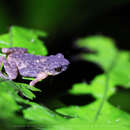Description
provided by AmphibiaWeb articles
Females range from 23.3-25.2 mm SVL while males range from 22.9-23.3 mm SVL. The head is as long as the snout. The canthus rostralis is distinct. Distinguishing characters include a visible tympanum, a first finger that does not extend as far the disc of the second when adpressed. the absence of a tarsal ridge as well as the lack of a white marking from the eye to the arm, numerous small yellow spots on the abdomen, and a uniformly dark upper lip. A longitudinal opening into the medial subgular vocal sac is present on the right side of the mouth. A single row of conical tubercles is present underneath the lower jaw. Fingers are not slender, and lack dermal fringes. Webbing reaches the base of the subarticular tubercle of each finger. The fourth finger is longer than the second, which is longer than the first. The subarticular tubercles are indistinct. The inner metatarsal tubercle is distinct and oval-shaped; the outer metatarsal tubercle is rudimentary. Hindlimbs are 2.3 times the length of forelimbs. Tips of toes are swollen into small discs, and the toes are strongly webbed, with webbing reaching the discs of toes III and V. Subarticular tubercles are indistinct. The inner metatarsal tubercle is distinct. Males have nuptial pads with asperities, covering the dorsal surface of the metacarpal and the basal phalanx on Finger I.The dorsum is evenly tuberculated, with a mixture of small to tiny weakly spinose warts, while dorsal limb surfaces are covered with large and small conical warts. Abdominal areas and flanks have coarsely granular skin, and the pectoral and gular regions are finely granular. The forehead, interorbital, and parietal areas all lack ridges, and a tarsal fold is lacking as well. In preservative, the dorsum is dark brown with an oval cream interscapular spot. Limbs dorsally have traces of crossbars, while light dorsolateral markings are absent throughout. The ventral surfaces are brown with numerous small pale yellow spots. The gular region is brown with distinct bright yellow spots under the lower jaw. In general, females are larger than males. Females also seem to have a narrower head, internarial distance, upper eyelid, and smaller eyes. Both sexes are uniform in terms of coloring and and pattern of marking. Males have nuptial pads and a median subgular vocal sac.The specific name refers to the type locality of Doi Inthanon.
Matsui, M., Nabhitabhata, J., and Panha, S. (1998). ''A new Ansonia from northern Thailand (Anura: Bufonidae).'' Herpetologica, 54(4), 448-454.
Distribution and Habitat
provided by AmphibiaWeb articles
The species is only known from Doi-Inthanon, in Chiang Mai Province, Thailand. It is found at an elevation of 1350-1650 m.
Life History, Abundance, Activity, and Special Behaviors
provided by AmphibiaWeb articles
Ansonia inthanon is often found at night along small mountain streams, perching on low vegetation along the banks, or occasionally on low vegetation along mountain paths. One specimen was found in the daytime under a fallen banana tree near a stream. Early August seems to be outside the breeding season as indicated by lack of mating calls from males, eggs, or tadpoles.
Ansonia inthanon: Brief Summary
provided by wikipedia EN
Ansonia inthanon is a species of toad in the family Bufonidae.
A small stream toad, measuring only 22-26mm in length. Its natural habitat is near torrents in subtropical forest on sloping land. It is threatened by habitat loss for agriculture, use by medical research (although this is not a significant threat) and by the introduced American bullfrog. Though it is only known from Doi Inthanon National Park and Thongphaphum in Kanchanaburi Province, it is not rare in suitable habitat. The species was recently discovered in a third locality, Doi Suthep National Park in Chiang Mai Province, and may also exist in similar habitat in northern Thailand and adjacent Myanmar.
- license
- cc-by-sa-3.0
- copyright
- Wikipedia authors and editors

